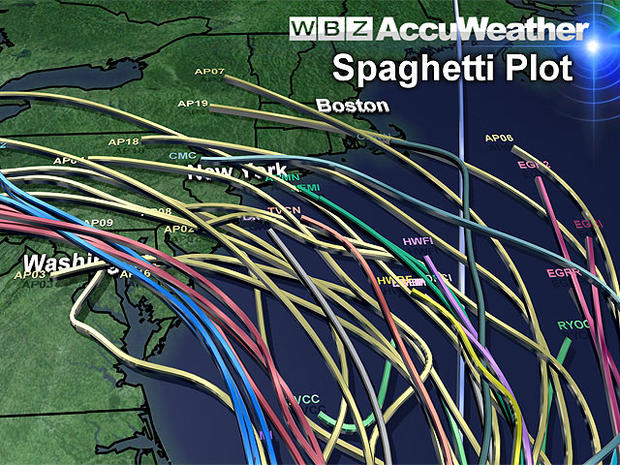Hurricane Sandy: Likely To Make Landfall On East Coast Monday Afternoon
BOSTON (CBS) - Some major developments in the past 24 hours with regards to Hurricane Sandy and its eventual track up the coast. First of all, the storm strengthened overnight into a category 2 hurricane.
Gallery: Latest Sandy Forecast Maps
This was significant that it was able to become more powerful while moving over land in the eastern half of Cuba. As of this morning, Sandy has re-emerged in the Atlantic and has begun the trek through the Bahamas island chain.
Sandy will likely remain a category 2 hurricane today, with sustained winds exceeding 100 mph.
Check: Current Conditions | Weather Maps | Interactive Radar
Sandy will then parallel the East Coast of the U.S. for the next several days, maintaining hurricane strength, although likely weakening a bit due to cooler ocean waters.
Just about every weather model in our arsenal has Sandy in a similar position on Sunday - a few hundred miles off the North Carolina coastline and this is when things get interesting.
Once Sandy reaches its position off of North Carolina, it will start to feel the effects of several northern latitude atmospheric conditions. A system born in the warm depths of the Tropics will find itself in unfamiliar territory…First, the warm ocean below which served as the engine to get Sandy going and keep it strong will begin to feel a lot different.
Typically a tropical system needs ocean temperatures 80 degrees or higher to sustain itself. The water off of North Carolina is now mainly in the 70s. Cooler ocean water being sucked into a hurricane is like throwing bad gas in a car…it doesn't run as smoothly and things start to break down.
Next, Sandy will start to feel a significant tug from a strong Jetstream. In the Tropics, steering currents in the upper atmosphere are very light, leaving large storms like Sandy to drive themselves for the most part. Not the case in our mid-latitudes…Jetstream winds several thousands of feet up in our region can reach 100mph or greater, taking the wheel from Sandy and directing the storm to its final destination.
It is also at this time when Sandy will undergo a transformation from a tropical system to what we call a "hybrid" storm.
Born of the warm tropical waters with a warm "core" at its center, Sandy will now take on the shape and characteristics of a northern latitude system, sort of like a Nor'easter on steroids. This transformation comes with both good and bad consequences. The center of the storm or "eye" will vanish along with the strongest winds at its core. BUT, powerful hurricane force gusts will actually expand outward from the center for several hundred miles, making the storm more destructive over a wider area.
So, the million dollar question remains…where does Sandy go once she reaches the waters offshore of North Carolina?
90% of all weather models now predict a landfall somewhere between New York City and Dover Delaware. The farther south it makes landfall the better for us and at least for today the latest indications are that Sandy will come ashore far enough away from Boston to spare us from the more severe weather and damage.
I would caution that there is still plenty of time for shifts in the track and the atmosphere undoubtedly has a few tricks up its sleeve that have yet to be revealed.
IF, the track were to come farther north and make landfall in Southern New England, effects would be much worse. This would be an historic storm, rivaling other Halloween storms of the past, like that of last year and even The "Perfect Storm" back in 1991.
Our Coastline would be most at risk where some major coastal flooding and beach erosion would be certain. Inland, several inches of rain would cause streets and basements to flood quickly. Winds could gust near hurricane strength, bringing down numerous, still foliated trees. Despite the work the electric companies have done to trim back trees since last October's storm, thousands of power outages would be inevitable. Again this would be a worst case scenario, but one that is still on the table as of today.
While this forecast is likely to change to some degree, we can say with near 100% certainty that New England will feel some effects from Sandy early next week. You should begin to prepare your home and family for the worst case scenario and most importantly stay tuned to updated forecasts throughout the weekend.
You can follow Terry on Twitter at @TerryWBZ.




